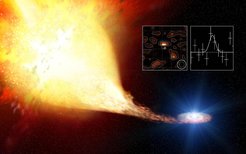Igniting a supernova explosion
with Prof. Roland Diehl, MPE

In January, a supernova explosion, called SN2014J, was reported in a nearby starburst galaxy, called M82. Serendipitously, this supernova was discovered before it reached its peak brightness. ust two weeks later, astronomers were able to take data with the INTEGRAL space telescope, which collects high-energy gamma rays. Surprisingly, the astronomers found traces of the radioactive decay of nickel. This element, however, is thought to be produced mainly in the centre of the exploding star; this means it should be hidden and could not be observed directly.
During the next Café & Kosmos, Prof. Roland Diehl from the Max Planck Institute for Extraterrestrial Physics will explain how this observation happened and present ideas on how this result could be interpreted.
